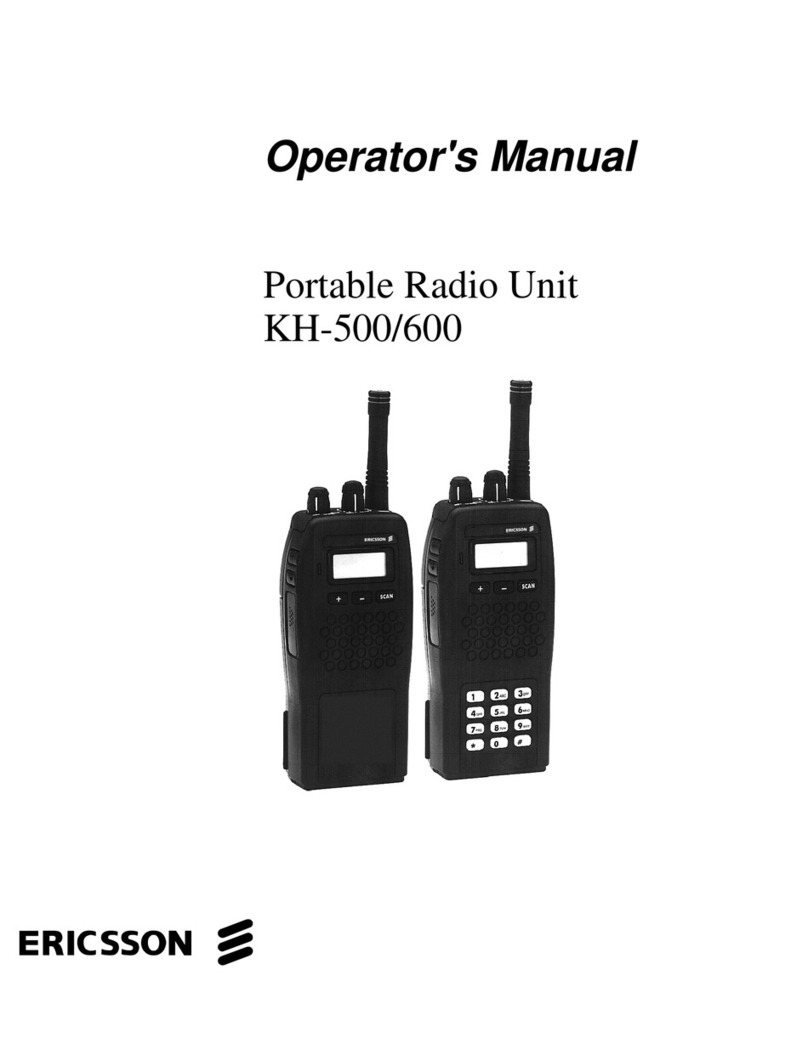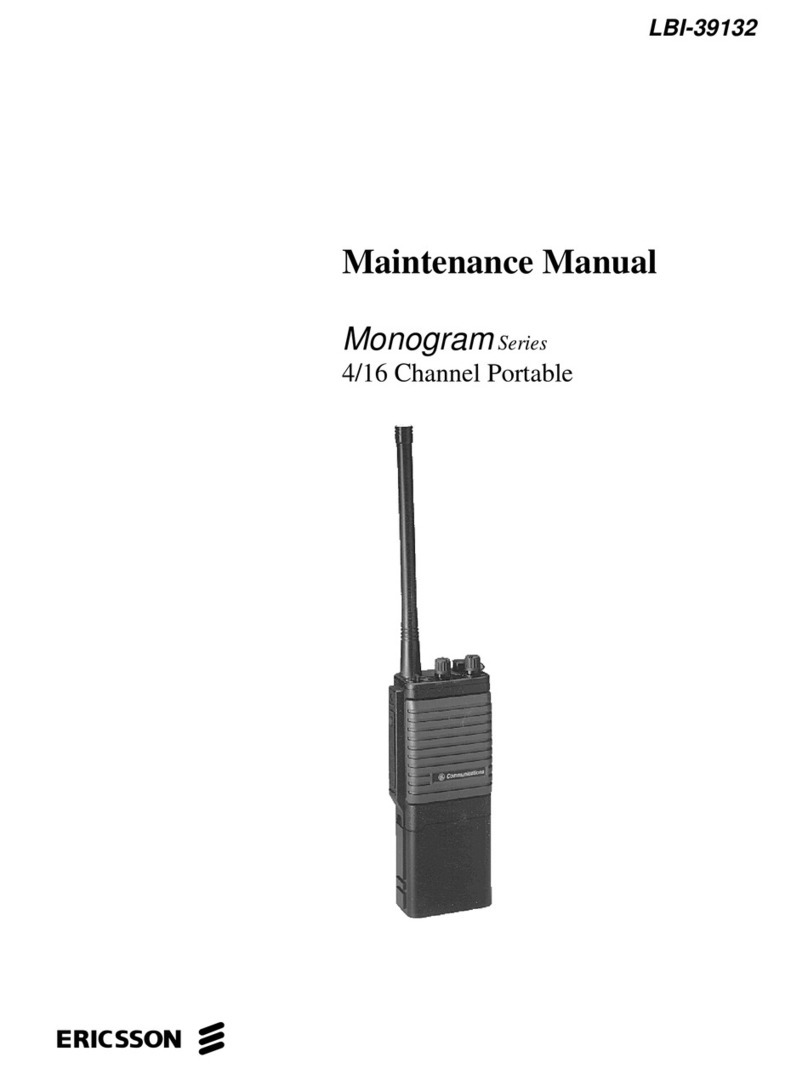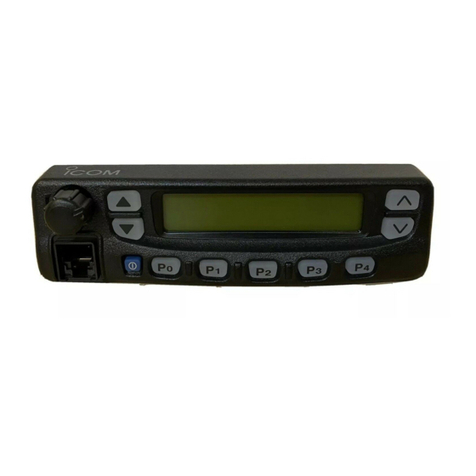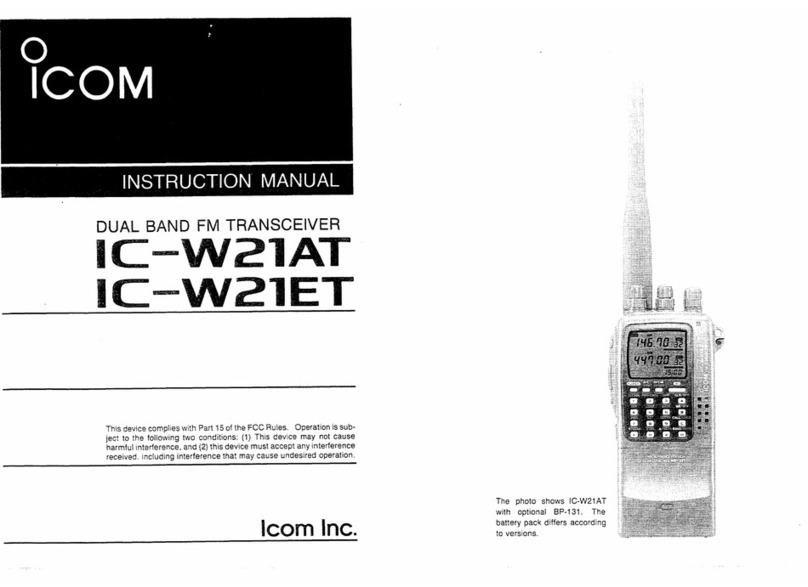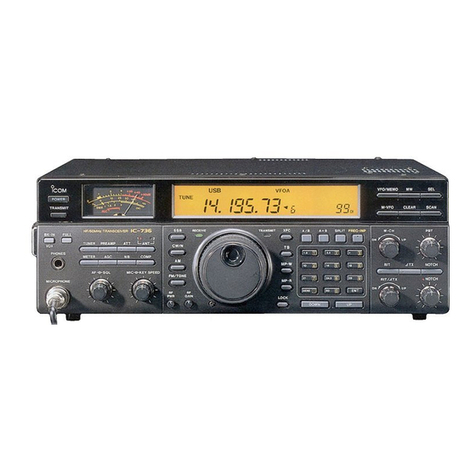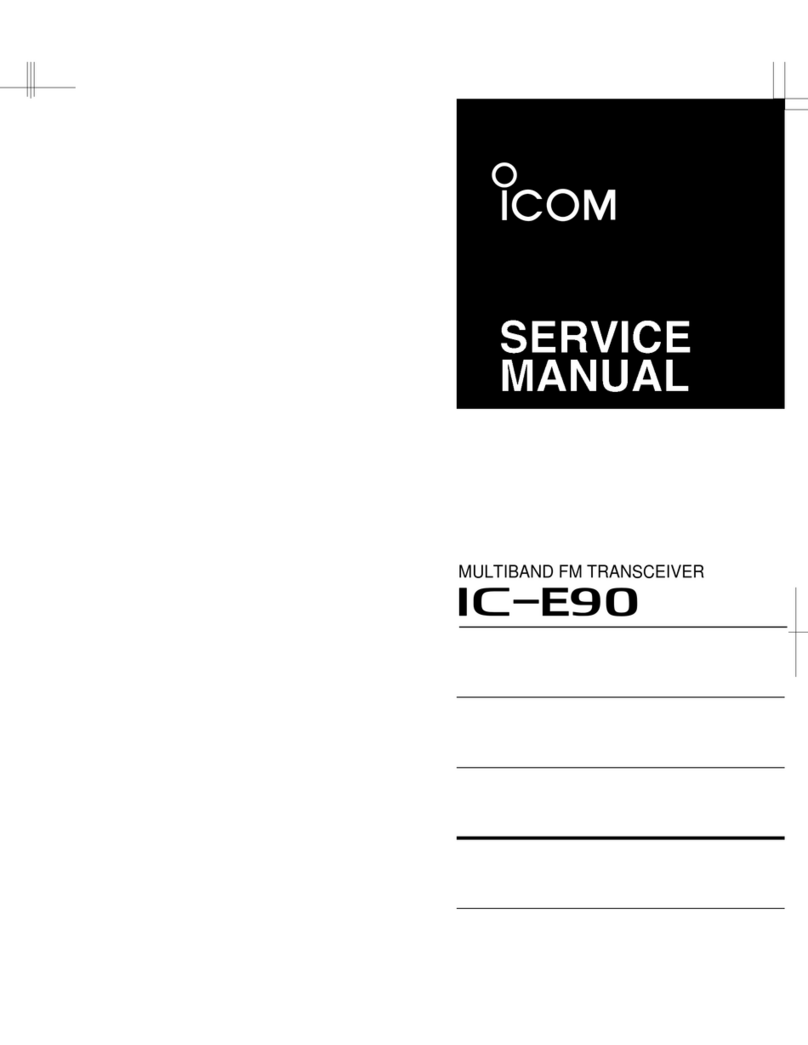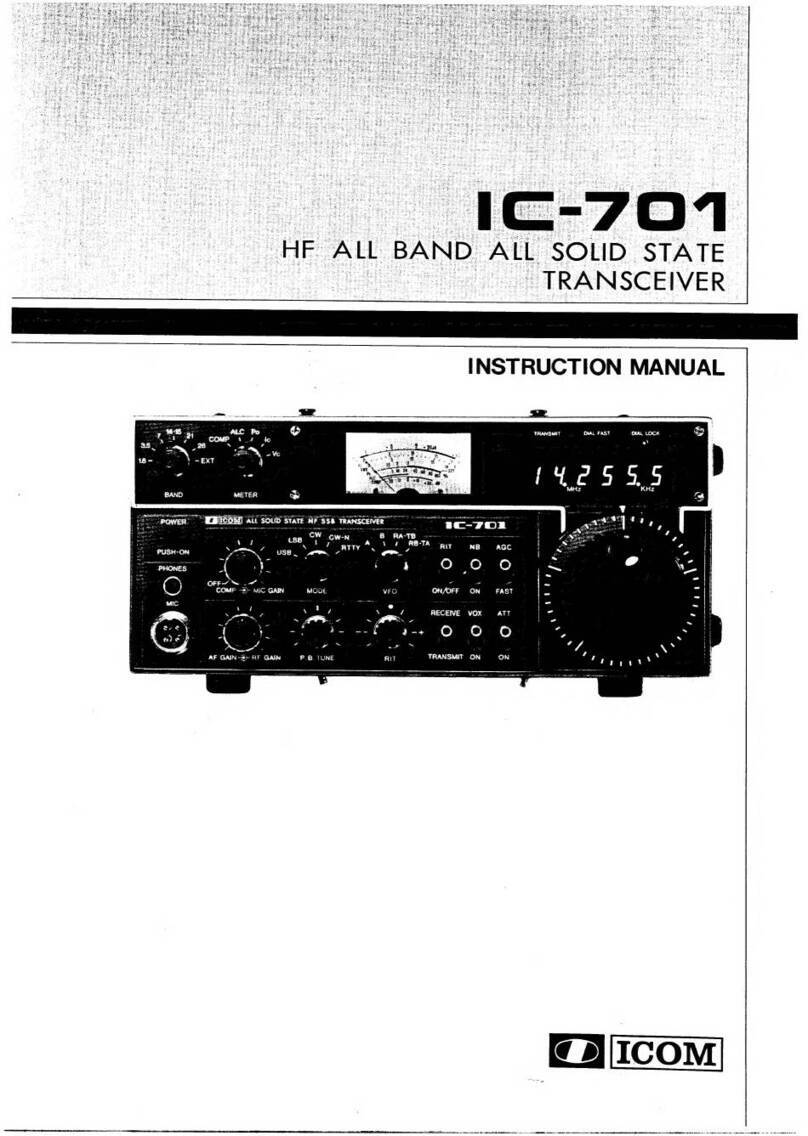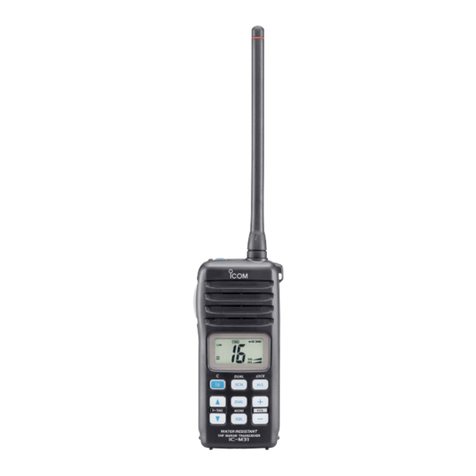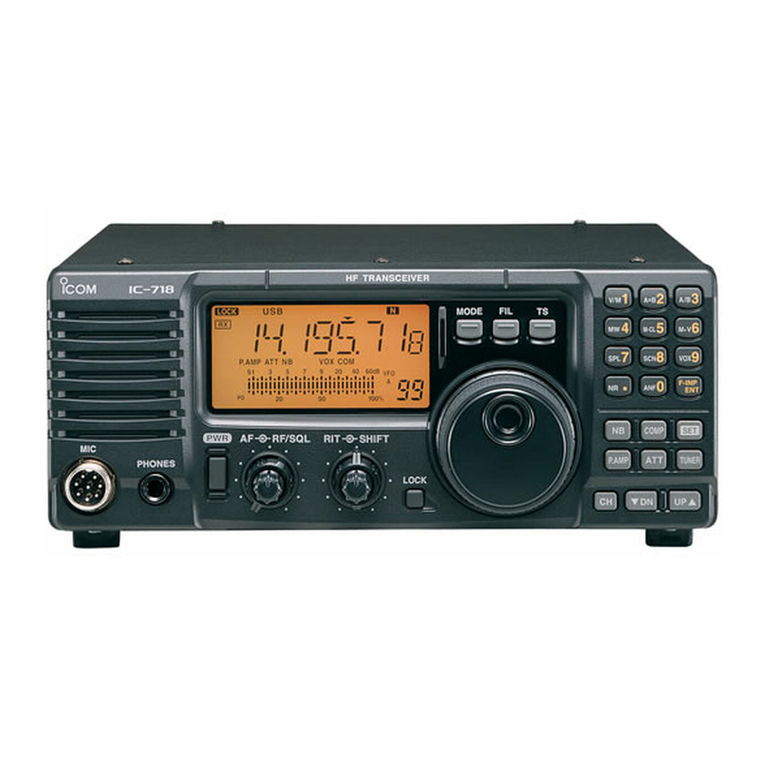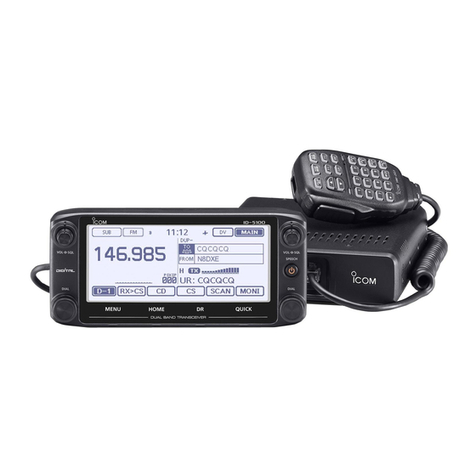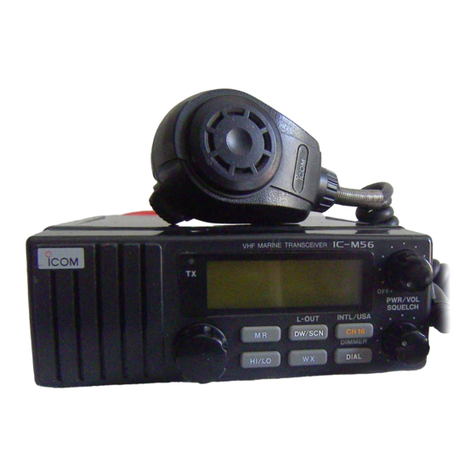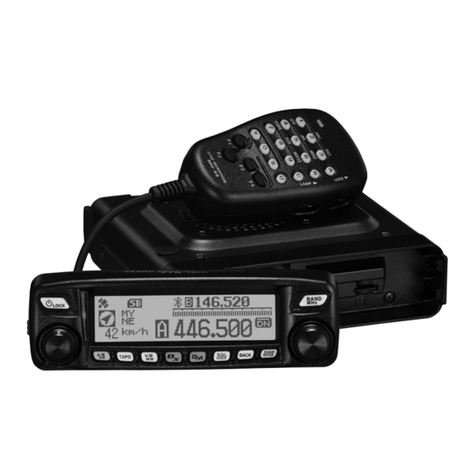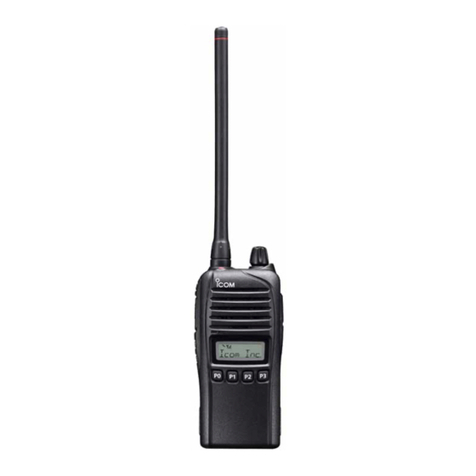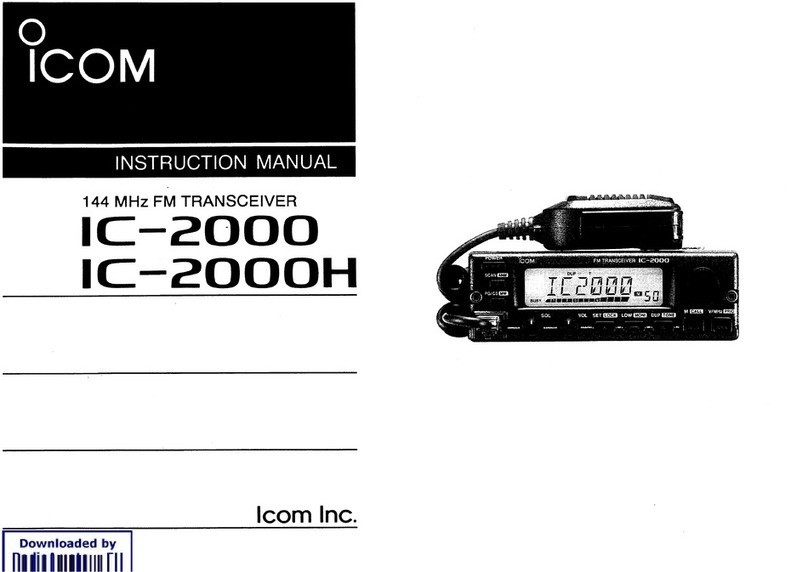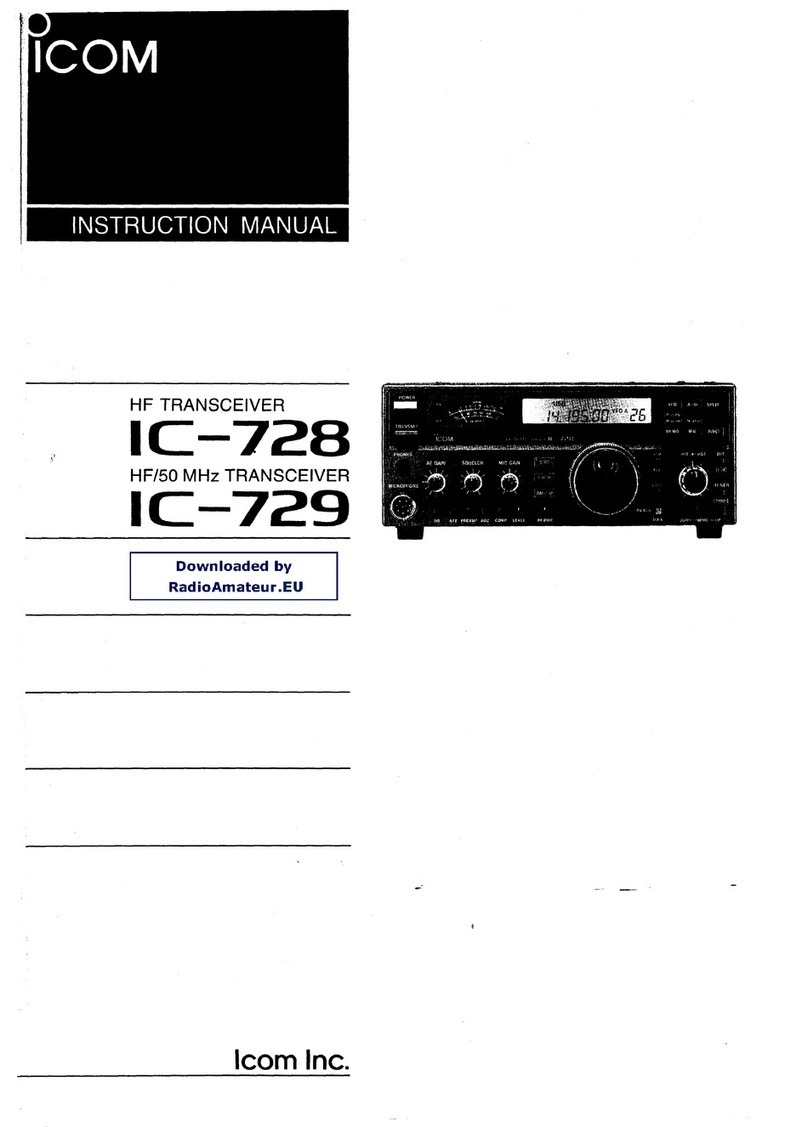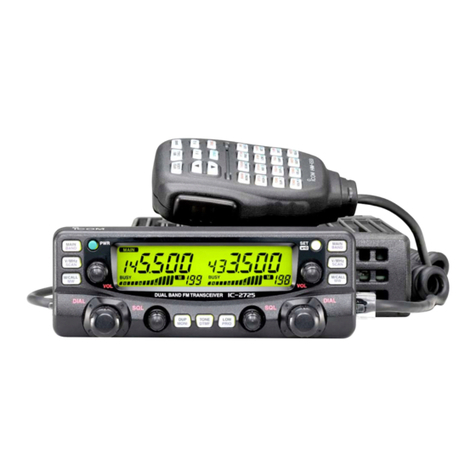Ericsson C605 Maxicom User manual

ERICSSON
;i5
Service manual
470 MHz Mobile radio station
C605 Maxicom
Standard version for cipher,
duplex and data communication
I I t I I
Il
I I 1 ' 11 I I
I
Il
I I I I
I l I I I 1
I I l
I
I
J
I
J
•
I J
I I
I I
' •

--
--
-
-
-
-
.,
.,
....
...
Contents
1. Introduction
General
...........................................
7
2. Technical data
General
...........................................
7
Transmitter
.......................................
7
Receiver
..........................................
7
Tone receiver and tone transmitter
...............
7
Regulator
.........................................
7
Cipher
............................................
7
3. Installation
General
...........................................
8
Divided installation
...............................
8
Installation of the control unit
....................
9
Installation of radio and cipher
...................
9
Installation of handset
with holder
........................................
9
Installation of loudspeaker ......................
10
DC
power connection
..........................
10
External alarm relay ............................ 10
Antenna installation
............................
10
4. Operating instructions
General
.........................................
11
Controls and indicators .........................
11
Button set
.......................................
12
Display
.........................................
12
Incoming calls
..................................
13
Outgoing calls .................................. 13
Other functions ................................. 14
Who has called ................................. 14
Status reporting ................................. 14
Accessories
.....................................
15
5. Circuit description of radio parts
Regulator
.......................................
15
Reciver
.........................................
15
RF
section and first IF section ..................
15
Second IF section ............................... 15
Squelch and
AF
sections ........................
15
Duplex transmitter
..............................
16
Generation on the carrier
.......................
16
Controlling the
VCO
........................... 16
Power amplification
.............................
16
Frequency generator
............................
16
Generation of the carrier ....................... 17
Generation
of
the voltage ...................... 17
Acquisition sequence ........................... 17
Control sweep when the
VCO
is
locked on ..... 19
Divisior and control voltage .................... 19
6. Description of the logic parts
General
.........................................
20
Block diagram description of the
micro computer
.................................
21
General program description
of
the
100 channel standard program
..................
21
7. Description of the cipher circuits
General
.........................................
23
Mechanical design ..............................
23
Transmission of plain text ...................... 24
Transmission of enciphered message ............ 24
8. Checking and adjusting
General
.........................................
25
Test equipment ........
..
.......................
25
Test set up ......................................
25
Checking the regulator .......................... 26
Checking and adjusting the frequency
generator ....................................... 26
Checking and adjusting the 1 band receiver ....
27
Checking and adjusting the duplex transmitter 27
9. Trouble shooting
Trouble shooting on unit level
in the car ........................................ 28
Central service ..................................
28
10. Spare
parts
Duplex transmitter .............................. 29
1 band receiver ................................. 30
Frequency generator ............................ 31
Regulator ....................................... 31
Logic board ..................................... 32
Control board ................................... 33
PROM
board ................................... 33
Display board ................................... 34
Bridgin board ................................... 34
Interconnection unit for cipher ................. 35
Connection unit ................................. 35
Interconnection unit ........................... . 35
Handset with holder ............................ 35
Interface board ................................. 35
Complete units ................ .................. 36
11. Block diagram, circuit diagrams and
component layout
Block diagram .................................. 39
Regulator board ................................ 41
Antenna filter board ..
..
........................ 43
Connector board for de and radio .............. 45
Connector board for loudspeaker and
handset
.........................................
47
Connector board for radio and logic boards .... 49
Connector board for cipher .....................
51
Bridging board for cipher ....................... 53
Cipher board 1
.................................
55
Cipher board 2 ................................. 57
Interface board for data communication ........ 59
PROM
board ................................... 61
Display board ................................... 63
Control board and code board .................. 65
Frequency generator board ..................... 67
Duplex transmitter board .. ..................... 69
1 band reciever board ........................... 71
Basic logic boards ............................... 73
5

6
List of figures
Fig 3.1
The
location
of
the control unit
and
the radio,
logic
and
cipher units in the car ........... 8
Fig 3.2
The
front panel, the control board, the display
board
is
put together in a housing
to
form the
control unit ............................... 8
Fig 3.3.
The
control unit
is
installed in plastic housing
and
installed into the dashboard
of
the car
and
connected to the radiostation via a flat
cable ................................. ..... 9
Fig 3.4.
The
installation
of
the radio
and
cipher cas-
settes and the location
of
the duplexfilter
and
data interface ...... ....................... 9
Fig 3.5.
The
connection
of
the handset to the circuit
board
of
the holder ................... .... 9
Fig 3.6.
The
connection
of
the holder's circuit
board
to
the connection unit .............. ..... . 9
Fig 3.7.
The
connection
of
the loudspeaker
to
the
holder's circuit
board
..................... 10
Fig 3.8.
The
connection
of
the station
to
the car's
battery
....................................
10
Fig 3.9.
The
connection
of
the external alarm relay
to
the connection unit ....................... 10
Fig 4.1.
The
station consists
of
a control unit, radio
and
logic units, cipher unit
and
duplex filter,
radio
and
cipher cassettes
..
.
..
..
..
.. ..
.
..
. 11
Fig 4.2.
The
control unit
and
the code memory plug
in board
...................................
11
Fig 4.3.
The
handset
and
its holder with controls and
indicators ................... . . ...... ..... .. 11
Fig 4.4.
The
button set includes number buttons for
entering digits
and
function selection buttons
for selecting the different functions ..... .. 12
Fig 4.5.
The
stations display with channel indicator,
number indicator
and
function lamps
.....
12
Fig 5.1.
The
control sweep
<luring
lock-on, measured
at
test point Tp7 .......................... 16
Fig 5.2 Control voltage
at
TPI when
cpA>
cpb
and
the
VCO
is
not
locked
....................
18
Fig 5.3 Control voltage
at
TPI when
VCO
is
locked
and cpA=
cpb
from
cpA>
cpb
........... 18
Fig 5.4 Control voltage at
TPI
when
cpA<
cpb
and
the
VCO
is
not locked
....................
18
Fig 5.5 Control voltage
at
TPI
when
VCO
is locked
an
cpA=
cpb
from
cpA<
cpb
............
19
Fig 5.6 Control sweep when the
VCO
locked in
transmission mode. ....................... 19
Fig 5.7 Control sweep when the
VCO
locked
inre-
ception mode. ............................ 19
Fig 6.1 Block diagram
of
the logic parts .......... 20
Fig 7.1.
The
ciphering unit
....
..
..
..
..
..
....
..
.
..
. 24
Fig 8.1 Removing the logic unit from the radio
unit
.......................................
25
Fig 8.2 Connecting the logic eliminator, the duplex
filter and the control unit to the stations
radio unit. ................................. 26
Fig 8.3 Regulator's testpoints
.....................
26
Fig 8.4
Fig 8.5
Fig 8.6
Fig 11.1.
Fig 11.2.
Fig 11.3.
Fig 11.4.
Fig 11.5.
Fig 11.6.
Fig 11.7.
Fig 11.8.
Fig 11.9.
Fig 11.10.
Fig 11.11.
Fig 11.12.
Fig 11.13.
Fig 11.14.
Fig 11.15.
Fig 11.16.
Fig 11.17.
Fig 11.18.
Fig 11.19.
Fig 11.20.
Fig 11.21.
Fig 11.22.
Fig 11.23.
Fig 11.24.
Fig 11.25.
Fig 11.26.
Fig 11.27.
Frequency generator's testpoints
and
trimmers .............. ..... . .... .......... 26
1
band
receiver's testpoints and trimmers . 27
Duplex transmitter's testpoints and
trimmers .............. . .... . .... . ......... 28
Block diagram .......... .... . .... . ..... ... 39
Regulator, component layout
.............
40
Regulator, circuit diagram
................
41
Antenna
filter, component layout
.........
42
Antenna
filter, circuit diagram
............
43
Connector
board
for de
and
radio, component
layout
.....................................
44
Connector
board
for de
and
radio, circuit dia-
gram
.........
,
............................
45
Connector board for loudspeaker
and
hand-
set, component layout
........
..
......
..
..
46
Connector
board
for loudspeaker
and
hand-
set, circuit diagram
....
..
............
.
..
..
. 47
Connector
board
for radio
and
logic boards,
component layout .............. . .... . ..... 48
Connector board for radio
and
logic boards,
circuit diagram .......... .... . .... . ........ 49
Connector board for cipher, component lay-
out
........................................
50
Connector
board
for cipher, circuit
diagram
...................................
51
Bridgin
board
for cipher, component
layout
.....................................
52
Bridgin board for cipher, circuit diagram . 53
Cipher
board
1, component layout ....... 54
Cipher
board
1, circuit diagram ..... ..... . 55
Cipher
board
2, component layout ....... 56
Cipher
board
2, circuit diagram ..... ..... . 57
Interface
board
for
data
communication, com-
ponent layout ................... . .... ..... 58
Interface
board
for data communication, cir-
cuit diagram
..............................
59
PROM
board, component layout ......... 60
PROM
board, circuit diagram
............
61
Display board, component layout .........
62
Display board, circuit diagram
............
63
Control
board
and code board, component
layout
.....................................
64
Control board and code board, circuit dia-
gram
......................................
65
Fig 11.28. Frequency generator, component layout .. 66
Fig 11.29. Frequency generator, circuit diagram
.....
67
Fig 11.30. Duplex transmitter, component layout
....
68
Fig 11.31. Duplex transmitter, circuit diagram ....... 69
Fig 11.32. 1
band
receiver, component layout ....... 70
Fig 11.33. 1
band
receiver, circuit diagram
..........
71
Fig 11.34. Basic logic, component layout ..... ..... .. 72
Fig 11.35. Basic logic, circuit diagram ..... ..... ..... 73
List
of
tables
Table 5.1. Divisors
and
control voltage
..............
19
Table 8.1.
De
levels
of
regulator
board
.............. 26
Table 8.2.
De
levels at connector
Pl
.................
26

1. Introduction
General
C605 Maxicom
isa
470 MHzmobileradio stationwith ciph-
er, duplex and data communication facilities.
In
its
standard version, C605 Maxicom has functions for in-
dividual calls and group calls, full number calls, automatic
calls, semiautomatic calls, emergency calls and programm-
ing
of automatic calls.
Further standard functions are open monitoring, externa!
alarm and retransmission to another station.
In
addition to showing channelnumberand call number, the
display tells you if somebody has called you while you were
away, ifthe channel you want to use
is
engaged, and also in-
dicates incorrect operation. Optional functions in C605
Maxicom include "Who has called" and status reporting.
Allthese functions areincludedin thismanual. Yourstation,
however, may not have been programmed to incorporate
them
all.
Accessories to C605 Maxicom include carrying case and
desk-top console.
2. Technical data
General
Frequency range:
Mode of operation:
Modulation:
Number
of
channels:
Channel spacing:
Frequency stability:
Antenna impedance:
Power supply:
Power consumption
transmission:
reception:
Ambient temperature
specified data:
operational:
storage:
Weight:
Dimensions:
Transmitter
380
...
470
MHz.
Simplex andduplex.
FM.
10,
20or100.
12.5 or
25
kHz.
+5ppm.
50Q.
12
or24V.
4.5A.
0.5A.
-25"C.
..
+55"C.
-40"C.
..
+70"C.
-55"C.
..
+85"C.
l.9kg.
180
x 212 x 54 mm.
Number of partial bands:
3.
Bandwidth within each partial
band.
12.5 kHz channel separation:
1.
75 MHz.
25
kHz channel separation:
3.
5 MHz.
Output power:
10
or
20
W +1 dB.
Hum and noise: -40 dB.
Unwanted radiation: < 0.25 uW.
Attenuation of modulation
products in adjacent channel.
12.5 kHz channel spacing:
60
dB.
25
kHz channel spacing:
60
dB.
Audio response
12.5 kHz channel spacing:
25
kHz channel spacing:
Reciver
300
...
2550
Hz, tol-
erance
+l
... -3 dB
rel.
-6
dB!octave.
300
...
3000
hZ, tol-
erance
+l
... -3 dB
rel.
6 dB!octave.
Number of partial bands:
1.
Bandwidth within each partial band.
12.5 kHz channel separation:
1.
75 MHz.
25 kHz channel separation: 3.0MHz.
Sensitivity
(1/2
EMF
at 12 dB SINAD).
12.5 kHz channel spacing: 0.45 u
V.
25 kHz channel spacing: 0.35 uV.
Hum and noise: -40 dB.
Selectivity
12.5 kHz channel spacing:
25
kHz channel spacing:
Intermodulation attenuation:
AF
power to loudspeaker:
Spurious response attenuation:
Spurious emission:
Distortion:
Audio response.
12.5 kHz channel spacing:
25
kHz channel spacing:
Regulator
Supply voltage:
Regulated voltage:
Voltage tolerance:
Maximum current load (at the
regulated voltage
of
9.3 V):
65dB.
70dB.
70dB.
4W.
80dB.
<2nW.
< 10%.
300
... 2550 Hz,
tolerance +1... -3 dB
rel.
6 dB!octave.
300
...
3000
Hz,
tolerance +1... -3 dB
rel.
6 dB!octave.
12
V.
9.3
V.
+O.l
V.
""'250mA.
Tone
reciver and transmitter
CCIR: 5 tone
and
5
and
7
to:?.e.
ZVEI: 5 tone.
No. of selectable combinations:
100
000.
No. of coded calls: 11.
No.
of
codes, tone receivers:
4.
Cipher
Traffic type:
Speech digitizing method:
Data rate:
Duplex.
ADM
(adaptive delta
modulation).
14.4 kbitls.
Data modulation:
NRZ
(non return to
zero).
Data bandwidth: 14-8500 Hz.
Radio bandwidth -60 dB: 55 kHz.
Radio bandwidth -70 dB: 70 kHz.
Temperature range: -1o·c.
..
+55"C.
Number of key combinations: 272
(4.
7x
10
21
).
7

Life
of
back-up battery
for cipher key: 5 years.
Level to modulator
Cipher mode:
1.
7Vp-p·
Plain text mode:
Nom
360
m
V,
Level from discriminator
1.
7Vp-p
max
increasing 6
dBI
loctave within
300...
2500
Hz.
Cipher mode:
470
m
Vp-p·
Plain text mode:
AF
level to the radio's
loudspeaker amplifier
Cipher mode:
Plain text mode:
Digital squelch
Cipher reception:
Plain text reception:
Cipher transmission:
Plain text transmisssion:
Link:
Non-link:
AF
in at link:
Microphone input:
Data out:
Data in at link:
Clock output:
Key loading:
Supply voltage:
Current consumption:
8
Nom
lOOmV,
470
m
vp-p
max
increasing 6
dBI
loctave within
300
... 2500 Hz.
Nom
200mVat
1
kHz
increasing 6 dB
loctave within
300
...
2100
Hz.
Nom
100
mVat
1
kHz
increasing 6
dBI
loctave within
300
... 2500 Hz.
Grounded.
Open.
Grounded.
Open.
Grounded.
Open.
Nom
lOOmV,
470
m
vp-p
max
increasing 6
dBI
loctave within
300
...
3000
Hz.
Nom40mV.
7VP-P'
14.4 kbitls.
7V-15
Vp-p
14.4 kbitls.
7VP-P'
14.4 kbitls.
300 bitls
ASCll,
Logic0=7V,
Logic l=OV.
10
... 16V.
30mA.
3. Installation
General
A complete mobile radio station C605 with cipher, duplex
anddatafacilities consists
of
radiowithradiocassette, cipher
unit with cipher cassette, handset with holder, antenna,
du-;
plexfilter, cables for interconnection ofthe parts, a connec-
torunit, mounting platefor thecassettes, housings, covers, 4
wire interface for the data communication and antenna.
Fig.
3.1. Thelocation
of
thecontrol
unit
and
theradio, logic
and
ci-
pher
units in the
car.
Divided installation
Divided mounting means that the station's front panel, dis-
play board, control board and code
board
is
put in a plastic
housing to
forma
control unit and then installed in thecar's
dashboard.
The
radio with the logic, cipher
and
duplex filter
is
installed
in the luggage compartment
of
the car.
Fig
3.
2.
The
front
panel, the controlboard, the display boardis
put
together in a housing to
form
the controlunit.

Installation of the control unit
The control unit
is
put in
an
installation housing andmount-
ed to the dashboard ofthe car,
and
connectedvia a flat cable
to the radiostation in the luggage compartment.
Control unit
Rearview
Fig
3. 3.
The controlunitis installedin plastichousing
and
installed
intathedashboard
of
thecar
and
connectedto theradiostation via a
flat cable.
__, Installation
of
the radio and cipher
-
--
--
-
-
The radio and cipher cassette
is
mounted together
on
a case
with fast lock facilities and locked
to
a mounting plate fixed
to the floor of the luggage compartment.
The
duplex filter
is
fixed
to
the top
of
the radio cassette, an-
tennafilter and datainterface are fixed
to
the rearend
of
the
radio cassette.
The
radio parts are connected to the control
unit via a flat cable.
Installation
of
handset with holder
The
handset
is
a modified "Diavox" handset for telephone
traffic.
The
holder has controls for power on, cipher
on
with lamp,
volume control and disconnection
of
call.
The
handset
hasa
T/R
switch.
Fig
3.
5.
The connection
of
the hand.set to the circuit board
of
the
hand.set holder.
Thehandset
is
connectedto the holder via a 6 wire cable and
the holder
is
connected to the connector unit via a 14 wire
cable.
---W
Fig
3.4. The installation
of
theradio
and
ciphercassettes
and
thelo- Fig
3.
6.
The connection
of
the holder's circuitboardto the connec-
cation
of
the duplex filter
and
data interface. tian unit.
-9

-
Installation
of
loudspeaker
The
loudspeaker has
60
ohms impedance and
is
connected
to the circuit board
of
the handset holder by a 2 wire cable.
Fig
3.
7.
The connection
of
the loudspeaker to the holder's circuit
board.
DC
power connection
The
stationis connected
to
thebatterybya 2 wire cable,
and
a 1 pole fuse holder.
The
earthpole
of
the cable is grounded
_to
the chassie
of
the
car, the plus pole
of
thecable
is
connected
to
theplus pole
of
the battery.
The
other
end
of
the cable
is
connected to the
connector unit.
Externa) alarm relay
The
extemal alarm relay unit
is
connected
to
the connector
unit via a 2 wire cable.
The
othertwo terminals
of
therelay can
be
connected
to
the
horn
of
the car, the headlights
or
other
source
of
alarm.
'l::::::=====+12V
Fig
3.
9.
The connection
of
the externa/alarm relay to the connec-
tion unit.
Antenna installation
The
antennais fixed
to
the
car
and
connected
to
theantenna
filter
at
therear
of
theradio cassettebya coaxialcablewitha
~
Fig
3.8. The connection
of
the station to the car's battery. fast connector.
10

-
-
4. Operating instructions
General
The C605
MAXICOM
consists
of
a control unit placed in
the dashboard
of
the car and radio, logic and cipher units
placedin cassettes in the trunk
of
the car.
The
duplexfilter
is
mounted at the
top
of
the radio cassette.
Fig
4.1. The station consists
of
a controlunit, radio
and
logic units,
cipher unit
and
duplex filter, radio
and
cipher cassettes.
Controls
and
indicators
Button
set
Code memory plug Display
Fig
4.
2.
The control unit
and
the code
memory
plug in board.
Display
Display with two-digit channelindicator
and
five-digit num-
berindicatorand indicatorlampsfor transmission, incoming
call, open monitoring, retrans- mission extemal alarm and
automatic functions dis- connected
Button set
For selection
of
channel, call number and other functions.
Code memory plog
Replaceablecodememoryplugwhich containsall individual
information about the station, e.g. its own call number.
Handset
Handset off answers
an
incoming call. Handset on discon-
nects an ongoing call.
Transmission
button
Volume control
Poweron
Handset
Fig 4.3. The handset
and
its holder with controls
and
indicators.
Transmission
button
Placed
on
the handset.
For
switching from reception
to
transmission. Press to transmit, release to receive.
Power
on
Placed on the holder.
Tums
on
power
to
the station.
Cipher
on
Placed
on
the holder.
Tums
on
cipher function.
Cipher lamp
Placed
on
theholder.
Lamp
on
indicatesthatcipherfunction
is
on.
Volume control
Placed on the handset.
Tum
theknob clock-wise to increase
the volume.
11

Button set
Number
buttons
Channel selection
Number
selection
Function selection
Light
intensity/Status
Programming
Call
Emergency
Disconnecting and listening
Fig
4.4. The button set includes
number
buttonsfor entering digits
andfunction se/ection buttons for se/ecting
diff
erentfunctions.
Number
buttons
The number buttons
~
to
~
are used for entering digits in
On/Off
The
button
(@
is
used for power
on/
off.
Function selection
button
The
function selectionbutton
~is
usedto selectopenmoni-
toring, extemalalarm, retransmission to anotherstationand
automatic functions disconnected. During a call, the button
has a squelch
on/
off function.
Disconnecting
and
listening
button
The
disconnectingandlisteningbutton(tJ
is
usedfor discon-
necting the station after a call
and
for temporary listening in
onaselectedchannel.
The
buttonmayalso beused
to
restore
the function lamps.
Emergency
button
The
red button
~
is
used to transmit an emergency call.
Display
Call
indicator/
Who has called
Number
indicator
automatic calls, semi-automatic calls, full number calls
and
Channel
indicator
channel selection.
The
buttons 0, 7, 9 may have a double
function, 0 as
WHC
button, 7 for status reporting and 9 for
retransmission.
Channel selection
button
The channel selection button
~
is
used when selecting the
channelfor an outgoing call
or
for openmonitoring.
It
is
also
used for reset after incorrect operation.
Number
selection
button
The number selection button 8
is
used when selecting the
call number for an outgoing call,
or
in own programming of
automatic calls.
It
is
also used for reset afterincorrect opera-
tion.
Programming
button
The programming button
~
is
used for programming auto-
matic call numbers and for displaying automatic calls num-
bers.
Call button
The call button
~
is
used to transmit a manual full number
call, a
WHC
recall, or a status call.
Light
inten~/Status
button
The button
~
is
used to showthe display contents with high
light intensity. With the station in stand-by and the display
extinguished, this buttonwill displaythelastmobile number.
In systems with status reporting, thebutton
is
used to display
the currentstatus. When enteringdigits, this buttongives en-
try of the entry
symbol"-".
12
Open
monitoring
Retransmission ExternaI
alarm
Automatic
functions
disconnected
--
Fig
4.
5.
The station
's
display with channelindicator,
number
indi-
cator
and
function /amps.
Channel indicator
The
two-digit channel indicator shows the channel in use.
Flashing digits indicatethat somebody has calledyou onthat
channel while you were away. In stations with extra func-
tions, channelselection
00
means thatthe stationwill selecta
free channel automatically.
Number
indicator
Thefive-digit channel indicatorshows theselectedcall num-
ber. In stations with WHC, the number indicator also shows
the number
of
the calling station. In stations with status re-
porting, the status code
is
shown here. Incorrect operation,
e.g. selection
of
a channel which does not exist, will bring up
the word
Error
in the number indicator.
Call
indicator/"Who
has called"
The
yellow lamp
is
lit with steady light
<luring
a connected
call.
It
flashes to indicate unanswered incoming call.
..,.
....,.
.........
.........
.~
-
r-
r-
-
-

Transmission/Channel engaged
The red lamp lights with steady light to indicate that the se-
lected channel
is
engaged.
An
attempt
to
make a call
on
an
engaged channel will result in busy
tone
and disconnection.
During an outgoing call, the lamp
is
lit with steady light, but
flashes when the transmission button
is
pressed down.
Open monitoring
The lamp by the symbol
111111
lights
up
when the station
is
in
open monitoring mode.
Retransmission
The lamp by the symbol Plights up
to
indicate retransmis-
sion on.
Externa) alarm
The lamp by the symbol M lights
up
to indicate external
alarm on.
Automatic functions disconnected
The lamp by the symbol 6.lights
up
when automatic func-
tions are disconnected
(=
the station
is
locked
on
the select-
ed channel).
Incoming calls
Individual calls
A call signal
is
heard over the loudspeaker, the channel
indicator flashes
and
the yellow lamp lights up.
Take the handset and answer. Press the transmission
button
on
the handset to talk, release it
to
listen. Flash-
ing red lamp verifies own transmission.
Disconnectthecall by replacingthehandset
or
bypress-
ing the disconnecting button
ltJ.
Group calls
The yellow lamp lights up.
Listen tothegroup message.
If
youneed
to
answer, pick
upthehandset andpressthetransmissionbutton. Flash-
ing red lamp verifies own transmission.
Do
not replace
the handset until the entire group call
is
finished.
The call
is
automatically disconnected.
Outgoing calls
Full
number
calls
Press the channel selection button
§l
Enter the channel number with the number buttons
@)
to
m.
The
selected channel number appears in the
channel indicator.
Press the number selection button
8.
Enter the call number with the number buttons
@)
to
m.
The selected call number appears in the numberin-
dicator.
Press the call button
~
to
transmit the call.
A reply tone confirms that your call has been connect-
ed. Take the handset
and
make your call.
Disconnectthecall by replacingthe handset
or
pressing
the disconnecting button
ltJ.
Memory
The
stationwill rememberthelastnumberyouentered,even
when
the display
is
extinguished
or
the station switched off.
To
repeat this call, press the button
~
(the number
is
now
displayed)
and
then the call button
ltJ.
Automatic
calls
Automatic call means making a complete call with channel
numberandcallnumbersimplybypressingonenumberbut-
ton,
on
which all the necessary information has been pre-
programmed.
Presstheappropriatenumberbutton@)
tom.
The
pre-
programmed channel and call number appear in the
channel indicator
and
number indicator.
A reply
tone
confirms that your call has been connect-
ed. Take the handset
and
make your call.
Disconnectthecall by replacing thehandset
or
pressing
the disconnecting button
ltJ.
Semi-automatic calls
Semi-automatic call means that part
of
the call number has
been programmed in advance,
and
that you must enter
one
or
several digits to complete the call number.
Press the number button
@)
to
m.
The
display shows
the pre-programmed digits followed by dashes in the
positions where you must enter a digit.
Enter
the remaining digits
of
the call number with the
number buttons
@)
to
m.
A reply tone confirms that your call has been connect-
ed.
Take
the handset
and
make your call.
Disconnectthe call byreplacing the handset
or
pressing
the disconnecting button
ltJ.
Programming automatic calls
Programming an automatic call means storing a call, com-
plete with channel number
and
call number,
on
one of the
number buttons.
Press the channel selection button
~-
Enter
the channel number with the number buttons
@)
to
m.
The
selected channel number appears in the
channel indicator.
Press the number selection button
8.
Enter
the call number with the number buttons
@)
to
m.
The
selected call numberappears in the number in-
dicator.
Press the programming button
(@.
13

Press the number button
~
to
~
on which you want
the call stored. You have now stored an automatic call
for convenient access simply by pressing the chosen
number button.
You may check what call numbers are pre-programmed on
the different number buttons by pressing the programming
button
~
and then one
of
the number buttons. The display
will
show the automatic call number.
Other functions
Temporary listening
By
pressing the listening button (t) you can listen in on on-
going conversations on the selected channel for twenty sec-
onds, whereafter the station returns to stand-by mode.
Open
monitoring
Selectthechannelyou want tolisten
to
by pressingthechan-
nel selection button
~
and then enter the channel number
with the number buttons
~
to
~.
Press the function selec-
tion button muntil the lamp by the symbol for open moni-
toring -4 lights up.
To return to stand-by mode, press the function selection
button muntil all the function lamps are extinguished.
External alarm
Withtheexterna!alarmfunction, aspecialtoneforincoming
calls
is
heard. Via a relay, this tone can activate the vehicle
horn.
To select externa! alarm, press the function selection button
muntil the lamp
by
the externa! alarm symbol M lights up.
To retum to stand-by mode, press the function selection
button muntil all the function lamps are extinguished.
Retransmission
to
another
station
Presetchannelandcallnumberinthesameway as when pro-
gramming an automatic
ca1l
and store on number button
~.
To retransmit calls, press the function selection button m
until the lamp by the symbol for retransmission Plights up.
To
retum
to stand-by mode, press the function selection
button muntil all the function lamps are extinguished.
Automatic functions disconnected
Automatic functions disconnected means that the station
is
locked on the set channel and will not receive calls
on
other
channels.
Todisconnect automaticfunctions, press the function selec-
tion button muntil the lamp by the symbol for aatomatic
functions disconnected
!::,.
lights up.
To retum to stand-by mode, press the function selection
button muntil all the function lamps are extinguished.
Error indication
Incorrect operation will bring up the word Error in the dis-
play. Start from the beginning.
If
you have selected the wrong channel numberorcall num-
14
ber, press the channel selection button
~
orthe number se-
lection button 8 respectively, and
enter
the correct
number.
Time limits
The station may be programmed with various time limits,
e.g. automatic disconnection if the station neither transmits
or receives carrier wave
<luring
a longer time period.
Transmission limit
This means that
<luring
a call you may transmit only for a
li-
mited time. After this time, the station will automatically
change to receiving mode.
To
continue transmission you
must release the transmission button on the handset and
then press it again.
Who has called?
Unanswered call
If
a call
is
not answered the caller may request a recall by
pressing the number button
~.
When contact has been
established the station will disconnects automatically and
the yellow call lamp goes out.
Recall
Uponyour
retum
afteran absence, your station may display
a channel number and call number. This tells you who has
called while you were away.
To
recall the displayed number, press the call button
~.
Queue
function
Thestation can storeup
to
fifteen unanswered calls. Thelast
call
is
shownin the channel andnumberindicator
of
thedis-
play. The digits in the channel indicator and the yellow call
lamp flash.
To
checkwho has called, you may step back in the queueby
repeated pressings of number button
~
until you reach
stand-by mode.
Pressing once more
will
bring up the latest call again. You
can also stepback in thequeuewith thebutton (t), but it will
at the same time erase the previous call in the queue.
To
callthenumbershowninthedisplay, pressthecall button
~.
The entire queue
is
erased when the station
is
switched
off.
Status reporting
Status reporting means that instead
of
personally making a
call you transmit a two-digit code with a meaning earlier
agreed upon.
Press the status button
~.
The first two digits in the
five-digit numberindicator show thelatest selected sta-
tus code.
Enter a new status code with the number buttons
~
to
~.
Thenew status code appears in thelast two position
of the number indicator. When the entry
is
complete,
the new codewill replace the oldonein thefirst two po-
sitions of the number indicator.
.-
-
. I
~
I
• I
~
~-

Transmit the status call by pressing number button
(?J
and the call button [8.
An
acknowledgement
tone
confirms that the call has
been received.
Accessories
Desk-top console
C605 Maxicom can be used as a base station, for instance in
an office.
It
can be suitably located as a desk-top console
with built-in connections for antenna and power supply.
Whenthestation
is
suppliedas a basestationit
is
calledB605
Maxicom.
Carrying case
Thecarryingcasemakes it possibleto carryyourC605 Max-
icom stationwith you
on
site.
It
canalso receive and retrans-
mit emergency alarms for example from a portable pocket-
size alarm transmitter.
5. Circuit descrip-
tion
of
radio parts
Regulator
Refer to fig. I
I.I.,
11.2 and 11.3.
Regulation
is
accomplished by series element
Vl,
a transis-
tor.
The
output voltage
of
the series element
is
sensed by
comparingthevoltage
dropped
acrossresistorR5 ofthevol-
tage divider consisting
of
R6, R7
and
R5 with a reference
voltage
of
4.7V.
The
difference in voltagecontrols the series
element.
Befeeding in a logic
"l"
or
a logic
"O"
inta
input
"SIR"
(pin
P1:6) the 9V output voltages,
+9T
and
+9R,
can be con-
trolled.
If
a logic
"l"
is
fed in, then
+9V
will be fed out
on
output
"+9R"
(pin
Pl
:5), while
+9V
will
be
fed out
on
out-
put
"+9T"
(pin P1:7) if a logic
"O"
is
fed in.
The
+9V
can
be
adjusted using test resistor R7.
Reciver
Refer to fig.
Il.I.,
11.32and11.33.
The
receiver
is
a double superheterodyne which obtains its
local oscillator signal from an extemal frequency generator.
The
voltage value
of
logical
"l"
is
+9,
of
logical "O'',
OV.
The
voltage
+9
VT
is
present <luring transmission and the
voltage
+9
VR
is
present <luring reception.
RF
section
and
first
IF
section
The
local oscillator signal from thefrequency generator
is
at
a frequency that
is
bellow the receiving frequency, at a dis-
tance equal
to
the first intermediate frequency.
Following first mixer
U8,
thedifference between the
LO
sig-
nal andthe
RF
signalfrom the aerial
is
obtained.
The
differ-
encefrequency
is
thefirst intermediatefrequency
and
is
21.4
MHz.
Second
IF
section
The
frequency
of
the second oscillator may be above or be-
low the first IF, at a distance equal
to
the second intermedi-
ate frequency, which
is
455 kHz.
Following the second mixer the difference frequency be-
tween the outputsignal
of
the second oscillator and thefirst
IFsignal
is
obtained. This differencefrequency
is
thesecond
intermediate frequency.
Squelch
and
AF
sections
The
squelch circuitfilters
of
thenoisein the
AF
signal atfre-
quencies greater than 15 kHz.
When
there
is
noise, a logic
"l"
is
fed out from the squelch circuit (pin Z3:5). When
there
is
no noise, that is when the carrier
is
being received,
the output
of
the squelch circuit will be
at
logic
"O".
The
blocking
of
the
AF
path
through the
AF
amplifier in
case
of
noise in dependent
on
external circuits.
Volume
is
controlled by external componentsin all types
of
receivers.
15

Duplex transmitter
Refertofig
11.1.,
ll.30and
11.31.
The transmitter has three main functions:
Generation of the carrier signal
Control
of
the
VCO
Power amplifications
of
the signal
The carrier signal
is
generated using the outputsignals from
the frequency generator, the
VCO
anda
crystal-controlled,
frequency-modulated oscillator (FMO). The
VCO
is
con-
trolled by a
DC
voltage generated with the aid ofa detector
circuit and a transmitterloop circuit. Theoutputsignal from
the
VCO
is
amplified in a power amplifier.
The voltage value oflogic
"l"
is
+9V,
of logic "O",
OV.
The voltage
+9
VT
is
present
<luring
transmission.
Generation
of
the carrier
The carrier
is
the output signal of the VCO.
To
permit the
adjustment
of
the carrier frequency
(fl)
to the correct fre-
quencydistanceform theoutputsignal
of
thefrequency gen-
erator (f2), these two signals are mixed in mixer Z4. When
theVCO
is
oscillatingatthecorrectfrequency, theoutputof
the mixer (thedifference frequency
fl-f2
will be
of
a certain
frequency). This signal
is
compared in the detector circuit,
Zl,
withthesignal from theFMO,f3, (the
FMO
is
designat-
ed U2:V2,
Vl)
which
is
the reference signal.
Controlling the VCO
TheVCO
is
controlledinthefollowingway.
The
two signals,
fl
-f2 and f3, are comparedin the detector circuit
Zl.
When
the radiotelephone
is
tumed
on, the difference between
thesetwo signals
is
large. Thedetectorcircuitfeeds outa
DC
voltage that differs from 7V.
The transmitter loop circuit senses that the voltage differs
from 7V and tums off the transmitter by closing the elec-
tronic switch on the transmitter loop circuit's upper output,
generatesa control sweep that
is
fed out
on
theloweroutput
ofthetransmitterloopcircuit Tp7 and blocks theintegrator
built into the transmitter loop circuit
Thecontrol sweep alters thefrequency ofthe
VCO
untilthe
differencefrequency, fl-f2,
is
exactly 11.4MHz. Thedetec-
tor circuit senses that the f1-f2 and
f3
frequencies are the
same and feeds out
7V
DC.
Thetransmitter loop circuit senses that
7V
is
fed in
on
its in-
put and locks the control sweep to the control voltagethat
hasjustset the
VCO
to the correctfrequency.
The
transmit-
ter loop
is
now locked on.
The
VCO
can now vary so much in frequency that the
DC
output voltage decreases as much as to 1V oras increases as
much as to
8V
without causingthe loop to lose lockon (i.e.,
the holding range
is
1-SV). The transmitter loop circuit will
immediately change the value of the control voltage to re-
tum
the
VCO
to the correct frequency any time it varies.
However, ifthe
VCO
should deviate so greatelyin frequen-
cy
thatthedetectorcircuit producesa voltagelowerthan 1V
or greater than 8V, the loop will be broken and the lockon
procedure will start over from the beginning.
16
The
AF
signal from thehandset
is
continuallysuperimposed
on the
DC
voltage fed out from the detector circuit. When
the loop
is
locked on, the transmitter loop circuit acts as an
integratorandthevariations
of
the
AF
signalresultinavary-
ing control voltage which changes the frequency of the
VCO. In this way modulated carrier
is
obtained and then
transmitted.
Fig
5.1. The controlsweep during lock-on, measuredattestpoint
Tp7.
Power amplification
Theoutputsignal from the
VCO
receives its final amplifica-
tionin thepoweramplifier. Thepower
out
mayberegulated
byvaryingtheoutputvoltagefromthevoltagecontrolcircuit
consistingofV5-V9. Thedesiredpower outcan beadjusted
using potentiometer R25.
If
alogic "1"
is
fed in
on
pinP
1:
2, "Powercontrol",thepow-
er output will be decreased to approximately half. Unless
both ofthe voltage control circuit's input conditions are sa-
tisfied, the power amplifier will
be
shut off.
Frequency generator
Referto
Jig
11.1, 11.28 and11.29.
The Frequency Generator
is
of
the digital synthesizer type.
Thecarrier
is
generatedinafree-running, voltagecontrolled
oscillator (VCO) which oscillates directly at the radio fre-
quency by means of a phaselocked feedback loop.
Thevarious channelsareselectedbymeansofa binarynum-
ber, thedivisor N,
sentto
thecontrolcircuits oftheFrequen-
cy
Generator. Eachdivisorcorrespondsdirectly
toa
channel
frequency.
The output signal from the
VCO
can be used as
local oscillator signal from the receiver
transmitter signal
<luring
simplex operation
oscillator signal to a transmission loop
<luring
duplex
operation (the transmission loop consists
of
a transmit-
ter that generates a transmitter signal at the proper du-
plex distance from the receiver signal).
The frequency generator has two main functions:
Generating the carrier signal
Controlling the
VCO

-
The
carriersignalis
generated
by
the
VCO
anda
channel
os-
cillator.
The
output
signal
from
the
VCO
serves as
the
out-
put
signal
of
the
frequency
generator,
while
the
channel
os-
cillator
is
used
to
provide
an
intermediate
frequency, which
after division is
compared
with a
reference
signal.
The
VCO
is
controlled
by
a
DC
voltage
generated
in a
loop
filter.
The
magnitude
of
the
control
voltageis
determined
by
the factor
by
which
the
intermediate
frequency
is divided
(the
divisor,
N).
When
the
VCO
commences
oscillating,
an
error
signal will result
from
the
comparision
mentioned
above
and
be
used
to
change
the
control
voltage,
and
thus
the
frequency
of
the
VCO,
until
the
error
signal
is
zero.
The
voltage value
of
logical
"1"
is
+9,
of
logical "O", 0 V.
The
voltage
+9
VT
is
present
during
transmission
and
the
voltage
+9
YR
is
present
during
reception.
Generation of
the
carrier
The
output
frequency
of
the
VCO
(fi) is
used
as
the
trans-
mittersignal during simplex
operation,
as
the
local oscillator
signal for
the
receiver
and
as
the
input
signal
to
a
transmitter
loop, which in
tum
generates
the
transmitter
signal
at
the
proper
duplex
distance from
the
receiver frequency
during
duplex operation.
(The
transmitter
loop
is
not
included in
thefrequency
generator.)
The
VCO
is
modulated
directly
by
the
AF
signal from
the
handset
preamplifier.
The
VCO
can
be
made
to
operate
on
up
to
three
partial
bands, since
the
channel
oscillator
Z8
is
equipped
with
three
crystaloscillators.
The
desired
frequency
band
is selected
by
feeding in logical
"1"
on
the
appropriate
input,
P1:4.
If
no
logical
"1"
is fed in,
the
oscillator
shown
lowest
on
the
func-
tional diagram
is
connected
up.
This position is normally
used
to
generate
the
transmitter
signal in simplex
(and
both
the
transmitter
signal
and
the
lo-
cal oscillator signal in duplex).
The
three
oscillators in
the
channel
oscillator
are
fully
com-
patible.
One
of
the
oscillators
is
connected
by
feeding a
current
into
one
of
inputs
Z8:2/6
via resistors
R12
and
R14.
These
are
the bias resistors for
the
oscillators.
The
output
signal from
the
channel
oscillator
(f
2) is mixed
with
the
output
signal
from
the
VCO
(f
1
).
The
differencefre-
quency is filtered
out
and
an
intermediate
frequency is
ob-
tained. This
intermediate
frequency is divided
by
means
of
a
programmable divider,
Z3,
to
obtain a frequency
of
25 kHz.
The
divider
is
programmed
with a
binary
number,
the
divi-
sor N. This
number
corresponds
directly
toa
channel.
The
divider
is
clocked
by
the
difference signal f1
-f
2
and
counts
from
the
number
N
down
to
0,
at
whichtime
the
output
pulse
is
generated.
The
output
signal from
the
VCO
is
composed
according
to
the following formula:
f1 = f2
+N0.025
where f1 =
the
output
freqeuncy
of
the
VCO
(MHz)
f2 =
the
output
frequency
of
the
channel
oscil-
lator
(MHz)
N =
the
divisor
It
is
apparent
from
the
formula
that
the
divisor
corresponds
directly
to
a
channel
freqeuncy
and
that
the
difference fre-
quency, f1
-f
2, also
corresponds
directly
toa
channelfrequen-
cy.
The
divisor
may
assume values
between
50
and
190
and
the
difference
frequency
may
assume values
between
1.25
and
4.75
MHz.
The
VCO
hasa
bandwidth
of
3.0
MHz.
Generation
of
the
control voltage
The
output
signal
at
25
MHz,
whichis
obtained
from divider
Z3,
is
compared
in
phase
detector
Zl
with
the
signal from
crystaloscillator
Z2b.
The
signal
from
the
crystaloscillator
is
divided (within
the
phase
detector)
to
obtain
a signal at
the
frequency
of
25
kHz
and
then
a
comparison
is
made
of
the
phases (
c:p)
of
the
two
input
signals.
Ifthe
phase
angle (c:pA)
ofthe
divided signal
from
the
VCO
is less
than
the
phase
angle
of
the
reference
signal (
c:pB)
(the
divided signal from
the
VCO
leads
the
reference
signal)
the
phase
detector
feeds
out
a positive pulse train. This pulse
train
is
integrated
in
loop
filter
Z6
and
converted
toa
control
voltage which
is
a
DC
voltage
between
2
and
4.5 V
that
sets
the
VCO
to
operate
at
the
desired frequency.
The
control
voltage affects
the
capacitance
diades
in
the
oscillatorcircuit
of
the
VCO.
Each
channel
frequency
corresponds
toa
spe-
cific value
of
the
voltage.
If
the
phase
(
c:pA)
of
the
divided signal
from
the
VCO
is
greater
than
the
phase
angle
of
the
reference
signal
(c:pB)
(the
divided signal
from
the
VCO
lags
the
reference signal)
the
phase
detector
feeds
out
a negative pulse train. In this
case
the
control
voltage will
be
between
4.5
and
8.3 V.
Loop
filter
Z6
is
an
activefilter consistingprimarily
of
an
in-
tegrator.
The
integrator
comprises
operation
amplifier
Z6:Zl,
capacitor
C4
and
resistors
R3
and
R16.
The
charac-
teristics
of
the
integrator
must
be
adapted
to
the
various
op-
eratingconditions
by
connecting
and
disconnecting
the
var-
ious resistors in
the
resistance
network
which provides
the
bias for
the
operation
amp.
/ StCltion
tur
ned
on
4,5
v
---innnnnnnnrn
•.........•...•........
mnnnnnnnnnnnr
ov
__
uuuuuuuuuu
uuuuuuuuuuuuu
a.
Output
signal
from
phase
detector
Z1:13
4,5·5V
-----
1
-+-
U
Value
depends
1
on
loop
ampl.
I
I
ca
2V
I
1 110·20ms1
1
1-1
I I
---1
1--~~~~~~~-
2·
4ms/
\40·100ms
Z5:Z1b
on
ZS:Z1a
on
b.
Control
volta
ge
at
Z6:
10
TP1
111111111
I I I I
Il
I I I I
11111
I I I I
c.
Ouiput
signal
from
VCO
U1:5
with wrong
frequency
Fig 5.2. Control voltageat
TPI
whencpA >cpB
and
the
VCO
is
not
lock
ed.
17

4,SV~
OV--
I
I
a.Output
signal
from
phase
detector
Z1:13
n.--+--
uvalue depends
.
"J
on
loop
ampl.
T',
'VCO
locked
on.
I
'-----
Voltage
is
equal
to
selected
channel
b.
Control
voltage
at
Z6:10
TP1
I
Wrong
frequency
i Correct
frequency
\ i I
1111
I
11111
Ii
Ul.flJUU1JUUU1J
c.
Output
signal
from
VCO
U1:5
with
wrong
and
correct
frequency
Fig
5.3. Controlvoltageat
TPI
when
VCO
is
lockedandcpA=cpB
from cpA >
cpB.
Acquisition sequence
Whenthere
isa
largeerror(forexamplewhentheunit
is
first
tumed
on)it
is
necessary to ascertainthatthe
VCO
operates
within the range
of
regulation. This
is
accomplished as fol-
lows. When the error
is
great the phase detector provides a
pulse train from output 12.
The
pulse train
is
integrated
and
shaped in the fast acquisition circuit
Z5
and triggers a mon-
ostable multivibrator
Zlb,
which
is
also part
of
the fast ac-
quisition circuit.
The
monostable multivibrator closes electronic switch
Z5:Z2a, which in
tum
shorts the integrating capacitor, C4,
of integrator Z6:Z1.
The
integrator will now operate as
an
amplifier with unity gain and its output voltage will
be
4.5 V
which
is
approximately in the centre
of
the range
of
regula-
tion.
After 2 to 4 ms monstable multivibrator
Zlb
triggers mon-
ostable multivibrator
Zl
a
to
prevent
Zlb
from being trig-
gered again.
At
this point
of
time theshorting
of
theintegra-
tor Z6:Z1 ceases.
If
the output signal
on
Z
1:
13
of
the phase
detector
is
a negative pulse train, the controlvoltagewill fall
sharply
to
a value U depending
on
the amplification in the
phaselocked loop.
Then
the controlvoltage drops according
to a curve determined by the characteristics
of
the integrator.
As the control voltage drops, the frequency
of
the
VCO
is
changed and when the frequency has
dropped
so far that
is
correspondstothefrequency
of
thechannelthathasbeense-
lected (bymeans
of
thedivisorN usedto programmethediv-
ider
Z3)
the
VCO
will
be
locked
on
to
the frequency
of
the
channel andthe loop filter will provide a voltage that
is
pro-
portional to the channel frequency.
18
If
the output signal from
Zl:
13
is
a positive pulse train, the
process will be identical except that the voltage will rise
sharply to a certain value U when monostable multivibrator
Z5:Z 1b
is
reset.
As
in theabovecase, the voltage U
is
deter-
mined by the amplification in the loop.
If
the
VCO
does not
lock on, the above sweeping process will
be
repeated when
monostable multivibrator
Z5:Zla
is
reset.
To
ascertain that the loop filter has the appropriate charac-
teristics
<luring
the locking-in phase, electronic switch
Z5:Z2d
is
blocked
and
diode V3 conducts <luring the lock-
ing in, causing the resistor network that determines the bias
to the loop filter's integrator
to
be switched.
The
diode con-
ducts
<luring
the locking in because the phase detectorfeeds
out narrow positive "spikes", sufficient to keep the diode
open, from output
Zl:
13
at
the same time as the negative
pulse train
is
produced (if
A>
B). When the frequency has
locked in, that
is
when
A=
B, a positive voltage
of
4.5 V
is
fed out and
is
sufficientlylow
(and
has
no
positive spikes) to
keep the diode blocked.
The
diode blocks and opens at
about 5
V.
Di
ode
V4 in fast acquisition circuit
Z5
is
openedinthesame
manneras diodeV3 by the positive spikesfrom
output
13
of
the phase detector. DiodeV4
is
an
extrainput for triggering
monostable multivibrator
Z5:Zlb,
which
is
normally trig-
gered from output 12
of
the phase detector.
Duringtheentireacquisition periodtheradio trans- mitter
is
blocked by electronic switch Z5:V3 which
is
kept closed by
Schmitt trigger
Z5:V2/Z2e.
9V
=nJUUlfUUUlJ\l
·..................·lilllilimlilIUl
4,SV
a.
Output
signal
from phase
detector
Z1:13
8,3
V - - - - - - -
...,.
1
,..--------,
Value U
depends X
on
loop
ampl.
I
I
I
_,
2-4ms/
ZS:Z1bon
I
I
I
I
I
I
I
I
I
I
I I
I
20
ms
I
1-1
I
~
40-100ms
ZS:Z1aon
b.
Control voltage
at
Z6:10
TP1
11111
I I
1111
I I
Il
I I
c.
Output signal from
VCO
U1:
5
with wrong
frequency
I
111
111
Fig
5.4 Control voltage at
TPI
when cpA
<cpB
and
the
VCO
is
not
lock
ed.
r-
-
r-
r-
r-
r-
r-
.__,
-

u
Voltoge
~
depends
on
loop
ompl.
,,---
/
/
VCO
is
locked
on.
/ Voltoge is
equol
Jj-----
to
selected
chonnel
o.
Control voltoge
ot
Z6:10 T
P1
I
Wrong
frequency I Correct freq uency
\ i I
11111111
Il:
rlJUUU11l
D.
Output signal from
VCO
U1:
5 with
wron g ond correc t frequenc y
Fig 5.5 Control voltage at
TPI
when
VCO
is lockedan cpA= cpB
from cpA
<c.pB.
Control sweep when the VCO is locked on
The characteristics
of
the sweeping for transmission and re-
ception must be somewhat different.
For
transmission e.g.,
the
VCO
must notreactto rapidly,forthatwouldcounteract
modulation!
Fig 5.6 andfig 5.7, showstheappearance
of
thesweepfor re-
ception and transmission.
The
differences in characteristics
betweentransmission
and
receptionareaccomplishedbyus-
ing electronic switch
Z5:Z2b.
Sweep
when
not locked
on
'fA
<'fB
,..........-t---
8,3V
....................
...-
I
-----ro--..........
I
I
0-40
ms
J
-----
Voltoge levet corresponding
to
the frequency
of
selected
chonnel
"""
-----i-...._
I
--
Sweep
when
locked
on
'fA
>
<fB
1
--
1
-'t---~2V
I 0-
40
ms
I
I I
Fig
5.6 Controlsweep when the VCO locked
in
transmission mode.
Sweep
when
not locked
on
<f'A
<<fB
,,+---7V
//I
//
I
I
I
0-25ms I
Voltoge level corresponding
to the frequency of
selected
chonnel
"""
----h.
Sweep
when
locked
on
'fA
><fB
I',
I
',
I
't---3V
I I
I 0
-25
ms
I
~
..
Fig
5.
7 Controlsweep when the
VCO
lockedin reception mode.
Divisor and control voltage
The
characteristics of the loop filter must
be
changed for
!argedivisors, that
is
for divisors largerthan 128.This
is
done
with electronic switch Z5:Z2c. This switch
is
closed when
the most significant bit (128)
of
the binary divisor N
is
1.
As
mentioned above each divisor corresponds to a certain
control voltage. Table 5.1 shows the voltage corresponding
to
certain divisors.
Divisor N
50
130
170
220
Control voltage V
3
4
4.5
-5
6
Table 5.1 Divisors
and
control voltages.
19

6. Description
of
the logic parts
Block diagram description
of
the micro computer
INPUT
DEVICES
PROGRAM
MEMDRY
CDNTRDL
LDGIC
DATA
MEMORY
OUTPUT
DEVICES
Adress bus
lnput
port
ROM
CPU
Fig
6.1 Block diagram
af
the logic parts.
General
The
logic parts consists
of
a micro computer, a control unit
anda
code memory.
The
micro computer has in- and output gates, program
and
data memory and control logic.
Those parts are connected to each othervia the address bus,
the data bus and the control bus.
Theinput
and
outputdevices ofthemicrocomputerform the
interface between the computer
and
the external environ-
ment.
The
inputdevicesmaybea keyboard
or
inputportsfor
signals from other units in the system.
The
output
devices
may
be
a display
or
output ports for signals to other units in
the system.
The program memory
isa
read-only memory, i.e. a memory
containing permanently programmed information.
The
memory contains the program which controls the micro-
computer.
The
control logic reads this program, instruction
by instruction, and controls the other units accordingly.
The
data memory
is
used to store the data required by the
program.
It
may be a read-only memory
or
a
read/write
memory.
The control logic addresses, through the address bus, the
memory cell to
or
from which the data
is
to
be
communicat-
ed.
The
address signal which consists
of
a binary number in
parallel form,
is
fed from the control logic
to
the other units
of the microcomputer. This address signal points out the
corresponding unit.
Data and instructions are transmitted through the data bus
between the control logic, the memories and the input and
output devices.
Data
is
passed between the units which are
addressed in the form
of
binary numbers in parallel form.
Reset synchronizing signals and data direction signals are
passed through the control bus. Synchronization
and
data
direction signals indicate the direction in which data
is
to
be
20
Output
por!
RWM
Code
rnemory
Control
bus
-Data
bus
fed throughthedatabus
and
they
dock
thedatafrom thebus
inta memories
and
registers.
The
controllogic carries out the programinstructionsin two
stages. First, an instruction
is
fetched from the program
memory, the control logic then carries
out
the instruction.
The
control logic then fetches the next instruction and so on.
The
control logic fetches an instruction by passing the add-
ress through the address bus
to
the appropriate memory cell
in the program memory.
At
the same time, the control logic
feeds an outputsignal
on
to the control bus, which indicates
thatdata
is
to
be
passed from thedatamemory
to
thecontrol
logic. In this way, datais fed from theaddressedmemorycell
to the control logic through the data bus.
lf,
for example, the instruction that
is
fetched requires that
datashould befed from an inputdevice
to
the datamemory,
the control logic addressesthecorrectinputportandmemo-
ry cell throughtheaddress bus.
At
thesame time, the control
logic feeds an output signal in
to
the control bus to indicate
thatdata
is
tobe fed from the input
port
to
thedatamemory.
Data
which
is
carriedthroughthedatabus
is
clockedintathe
indicatedmemorypositionin thedatamemoryby one
of
the
signals
on
the control bus.
Microcomputer program
The
microcomputer
is
controlled by the instructions in the
program as follows: the control logic reads an instruction,
carries out the instruction, then reads the next instruction
and so on.
The
instructions may
be
of
the following types:
supply output data
to
memory
or
output device
supply input data from memory
or
input device
process previously entered data
jump
to
another place in the program
call for a sub-routine
....,...
r-
r-
r-
I
.--

Processing
of
previously entered data may include, inver-
sion, shifting, addingetc. A
jump
to
antoherplacein thepro-
gram may bea conditionaljumpsuchas
"Jump
ifthe
value0
is
obtained",
or
unconditional.
A call to a sub-routine
is
used when the same operation
is
to
be performed
on
a number
of
occasionsinthe program.
The
instruction causes a
jump
to a sub-routine; the sub-routine
ends by a
jump
back to the place from which the initialjump
to the sub-routine was made.
A jump
to
a sub-routine may also be initiated by a logic sig-
nal to the control logic. This signal, called an "Interrupt"
(INT)
is
used when a unit in the system requires immediate
attention. When the signal
is
activated, the control logic in-
terrupts the program
and
jumps
to
a special "Interrupt rou-
tine". This routine finishes by returning
to
the interrupted
program; running
of
the programis resumed from the point
at which the interrupt signal was received.
General program description of the
100-channel standard program
The program description
is
intended
to
explain how the set
works togetherwith its program.
The
program ofthe set has
two mainfunctions:
to
handleradio traffic and
to
controlthe
set intemally.
Code memory
In order to operate the set must
be
provided with a code
memory.
The
codememoryconsists
of
a read-only memory
which contains
512
words, 4 bits wide. This memory con-
tains information about for example: Channels
and
radio
frequencies, monitoring
of
incomming calls, what actions
are to becarried
out
when
an
incoming call has beenaccept-
ed, what call number that will be sent when a direct dialling
key
is
pressed.
Start, on-switching
When the switch-on key
is
pressed certain initialising rou-
tines are performed in order
to
check the code memory.
The channel which was
on
the display immediately before
the set was switchedoff
is
still storedina certainmemory.
At
on-switching a check
is
madeto see ifthis channel
is
still de-
fined in the code memory.
Operation
When operating the set the content
of
the display
is
showed
with strong light intensity
<luring
a certain time after each
key-pressing. This time
is
5
or
10 seconds.
The
short time
is
used when showing a direct selection channel and at those
stateswherenormally nomorekeyis expectedto
be
pressed.
The long time
is
used at those cases where key-pressing
is
to
be expected.
Anyincorrect operation
of
the set causes
"Error"
to
appear
onthe display
<luring
2 seconds.
After
the 2 secondsthedis-
play shows the same content as before the incorrect opera-
tion.
Incoming calls, monitoring
mode
Is
-
Channel changing
is
carried
out
in accordance with the de-
finition contained in the code memory, where a maximum
21
channels can be defined.
For
eachchannel there
is
speci-
fied ifopenmonitoring,carrierwave monitoring,tonemoni-
toring and auto-channel monitoring are permitted. When
thestation
is
switched on, channelchanging starts at thefirst
channelfollowed by the next
and
so
on
until the last channel
is
reached, and then begins again at the first channel. '
Open
monitoring. This
mode
can be selected manually by
the mode selector
or
automatically after channelselection if
the channelhas been definedfor this inthe code memory. In
this
mode
carrier wave monitoring
is
carried out
on
the dis-
playchannel
and
on
thosechannelswhich havebeendefined
for this in the code memory.
Carrierwave monitoring
is
onlycarried
out
whenthe"open
monitoringmode" hasbeenselected. Carrierwavemonitor-
ing always takes place
on
the display channel and
on
the
channels which are defined for carrier wave monitoring in
the code memory.
When a carrier wave is found, the channel selector stops
on
thechannelin question andthechannel number
is
shown
on
the display with the engaged lamp lit.
When
a carrier wave
hasbeendetected, thechannelselectorremains
on
thechan-
nel until the carrier wave has been disappeared for 5 sec-
onds. This delay timeis
to
preventthechannelselector from
moving
on
when minor interruptions occur
on
a channel.
If
the T
/R
key
is
pressed when the channel selector has
stopped
on
a channel, connection
of
call will
be
made
on
this
channel.
Tone
monitoring.
The
set can monitor
up
to 4 different
types
oftone
calls
on
a maximum of21 channels.
The
chan-
nels which are to
be
tone monitored are defined in the code
memory.
The
display channel
is
always tone monitored.
Beforecommencing monitoring, the setnoticeswhich chan-
nel
is
display channel. A search
is
then made in the code
memory for information about this channel. Using this in-
formation, the frequency generator
is
adjustedfor reception
on
the channel concerned.
There
is
also includedin thecode
memory which 4
tone
calls that are
to
be monitored. Notice
that these 4 tone calls are identical for all 21 channels.
The
set now searches in the code memory for the first of these
calls
and
therefinds thefirst tonein this call. Withthis infor-
mation, thestationnow sets
out
to
detectthefirst tonein the
first call; the actual
tone
monitoring now begins.
The
set nowtries
to
receive thefirst tone in the first call.
If
a
tone
is
not received
or
thereceived tone does not agree with
thefirst tone, the set tries
to
recieve the first tone in the sec-
ond
type oftone call.
The
four types
of
tone call
on
thefirst
channel are monitored followed by a change
to
the second
channel. This channel is monitored in the same way, fol-
lowed by the monitoring
on
the third channel and so on.
When the final channel has been monitored for tones, the
procedure starts again from the beginning.
21

Automaticity disconnected. In this mode, the channel se-
lector
is
locked
on
to the display channel.
Tone
monitoring
and carrier wave monitoring
is
carried
out
continously
on
this channel, Incomming calls are connected as normal. Af-
ter disconnection, the set remains locked
on
to
the display
channel.
There
is
nomaximumtimefor thechannelselectortoremain
on a continous carrier wave.
Pressing the T
/R
key gives connection
of
call.
Outgoing calls
Directselection.
If
a directselectionis
to
betransmitted
one
of
the keys which
is
intendedfor direct selection, a direct di-
alling key,
is
pressed.
The
set then reads the information
storedin the codememoryfor the keythathasbeenpressed.
If
thechannelnumber
is
correct, a tonecallwhich
is
specified
in the memory for direct selection,
is
transmitted.
If
there
is
any error, e.g. the channel numberin the memory for direct
calling
is
incorrect, the set continues monitoring
on
the se-
lected mode.
Relay. In the code memory information
is
stored, ifrelaying
ofincoming calls
is
to
be
carried
out
and
in that case, which
direct selection that will
be
transmitted.
When an incoming call has been accepted this agress with a
certain call-memory area in the code memory. This area
contains information about relaying.
Here
it
is
specified
which direct selection that will be transmitted. In other
wordsthesetsendsonanincomingcall intheform
of
a direct
selection.
Auto-channel monitoring. This monitoring always talie
place, provided that auto selection channels are defined in
the code memoring.
During the monitoring, the first unoccupied autoselection
channel
is
given.
If
this channel
is
engaged, thenthenext un-
occupied autoselection channelis given. Thismeans thatthe
autoselectionchannelsaremonitored
fora
longertimeinter-
val to give greater certainty that a particular channel
is
ge-
nuinely available.
When transmitting
on
autoselection channel, channel 00
shall be entered.
Handshaking procedure
Radio traffic between mobile andcontrol centre
is
preceded
by thehandshakingprocedure. Whena mobile calls the con-
trol centre the call consists
of
the ordinary 5-tone call num-
ber followed by a special numbercalled the identitynumber
(ID). When the control centre receives the
5-tone
call num-
ber and the ID number it sends back the ID number
to
the
mobile as a call acknowledgement. By doing this themobile
knowsifthetransmissionhasbeensuccesful
or
not.
After
the
mobile has received a correct ID connection
of
call can
be
made.
22
Alarm
traffic
Whenthe alarm call key
is
pressed, attemptsare made to es-
tablish contact with the alarm centre.
If
the alarm traffic op-
erates with alarmrepetitionwith ID-transmission procedure
1 takes place, if not the set continues with procedure
2.
1.
Handshake attempts are made first
on
all free channels
which are defined for alarm traffic in thecodememory.
If
the handshakingfails, thefirst busy channel
is
set and
a handshaking attempt
is
made
on
the channel in order
to "breakin".
If
handshakingfails heretoo, the next bu-
sy
channel
is
set andthe shaking attempt
is
repeated
on
all busy channels
and
then back
to
free channels again,
and so on.
If
any
of
thehandshakingattemptssucceeds, thesetswitches
to the conversation state and a conversation can take place.
2.
Inthis casethere
is
only
one
channelwhere alarm trans-
mission takes place. No carrier wave test
is
carried out
before transmission.
Time limits
Transmission time limit. This time limit is intended
to
pre-
vent unintentional locking
of
the T
/R
key in the transmis-
sion position.
When the time limit is reached, the set changes over auto-
matically from transmission
to
reception, as if the T
/R
key
hadbeen released. In order
to
againmove into the transmis-
sion mode, the T
/R
key must first be released
and
then
pressed again to restart the transmitter.
A new time limit
is
initiated each time the T
/R
key
is
pressed.
No
activity time. This time limit concems the time when a
mobile has been connected but neither has transmitted nor
received any carrierwave.
At
a certainmaximum time auto-
matic disconnection
of
the call take place. However when
dealing with alarm traffic this time limit
is
inoperative.
Listen time limit.Thistimelimit corresponds
toa
"no-activ-
ity time" which
is
independent
of
incoming carrier wave.
If
themobilemisses adisconnection
tone
thena newcall onthe
same channelshall not
be
able
to
keepthemobile connected
on
this channel longer than the listen time limit. When this
time
is
reached automatic disconnection
of
the call take
place, however not when dealing with alarm traffic.
A new time limit
is
initiated each time the T
/R
key
is
pressed.
Disconnection
A call
is
terminated by disconnection, either automatically
or
manually. After disconnection monitoring
is
started.

Automatic disconnection. The following cases cause auto-
matic disconnection:
Incoming disconnection tone
Time limit for
"no
activity" reached
Time limit for "listen time limit" reached
Automatic disconnection
is
not accompanied by transmis-
sion ofdisconnection tone. In the case ofalarm calls, auto-
matic disconnection
is
inoperative.
Manual disconnection.
The following cases cause manual disconnection:
Operation of the L key
Change of channel while in voice mode
Retum
of handset to holder
Transmission of disconnection tone.
Fortransmission
of
disconnectiontone, thefirst stationmust
be an A-subscriber. In addition, the code memory must al-
low transmission of disconnection tone.
Telephone mode
Thetelephone modeoperatesas special kind ofdirect selec-
tion. A call
is
initiated by pressing the telephone button
on
theset. Thesystemwill thenautomaticallyselecta free chan-
nel and connect a line circuit to a P
ABX
orpublic network.
A dialling tone will then be heard in the receiver. The user
can now dial any number
or
combination ofnumbers up to
16 digits
on
the keyset. The call
is
nowonly limited by those
limits existing in the telephone network.
7. Description
of
the cipher circuits
General
In the ciphering unit enciphering oftransmitted signals and
deciphering of received signals take place simultaneously.
The electronic circuitry ofthe ciphering unit
is
mostly con-
tained in five hybridcircuits placed
on
two circuit boards
Ul
and U2: see
fig
11.16 to 11.19.
A modem circuit
Z2
A delta modulator
Zl
A delta demodulator
Z3
A transmit (Tx) cipher circuit
Zl
(on
U2)
A receive (Rx) cipher circuit
Z6
The delta modulatorI demodulator circuits are identical
as
well as the ciphering circuits. Their function
is
determined
by the logic level on the mode-select inputs of the circuits.
Processing of analog signals, for both transmission and re-
ception,
is
carried
out
by the modemcircuit.
It
also digitizes
all received signals for further processing by the Rx-cipher-
ing circuit.
Analog-to-digitalconversionoftransmissionsignals
is
carri-
ed
out in the delta modulator. The circuit also contains an
analog noise generator. Digital-to-analog conversion ofre-
ception signals
is
carried out in the delta demodulator.
TheTx ciphering circuit enciphers the handset signal orthe
linked datasignal before it
is
transmitted. The Rx ciphering
circuit deciphers the received cipher signal.
Theciphering unit
is
intendedfor
NRZ
codedsignals with a
data rate
of
14.4
kbit/
s.
On
the
U2
boardthere
is
also a circuitfor generationofa da-
ta clock by which the deciphered (plain) data signal
is
clocked out into the B ciphering unit at link traffic.
A voltagesupervisor circuit
on
the
U2
boardshutsofftheci-
phering circuits if the battery voltage
is
too low, in order to
avoid incorrect ciphering.
Mechanical design
The Ciphering Unit
is
housed in a plug-in type metal case
which
is
placed in the cipher compartment ofan A station
unit.
Connectors for connection
to
the radio and the key pro-
grammer are located on the rear side ofthe case, see
fig.
7
.1.
Thecase
is
disassembledbyunscrewingfourscrews. Thetwo
printed circuit boards inside are joined by a multipole con-
nector.
23
Table of contents
Other Ericsson Transceiver manuals
